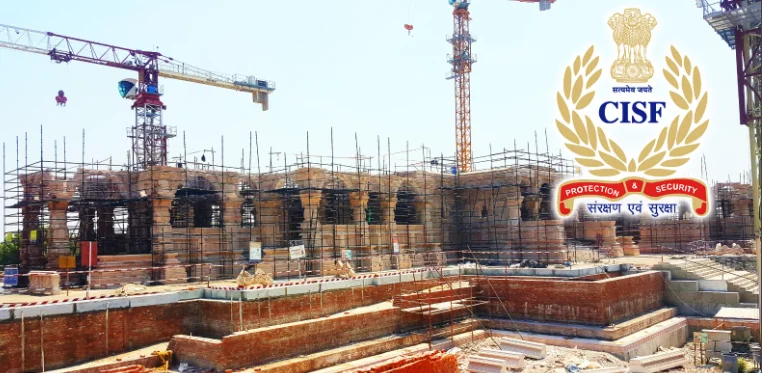
Ram Mandir Ayodhya Safety. In an era dominated by technological advancements, the integration of artificial intelligence (AI) has become a pivotal force in enhancing security measures across various domains. One such significant application is in safeguarding places of religious importance, where ensuring the safety of worshippers and preserving the sanctity of the premises is paramount. This blog explores how AI-based technology is employed to secure the revered Ram Mandir in Ayodhya, emphasizing tools, techniques, and strategies that contribute to a comprehensive security framework. ram mandir ayodhya
I. AI-Powered Surveillance Systems Ram Mandir Ayodhya Safety:
A. Smart CCTV Cameras:
- High-resolution cameras equipped with facial recognition technology are strategically placed across the temple premises.
- These cameras not only monitor the crowd but also identify potential threats by comparing facial features against predefined databases.
- Behavioral analysis algorithms help detect suspicious activities, ensuring timely intervention in case of any untoward incidents. Ram Mandir Ayodhya ka
B. Crowd Management:
- AI-driven crowd analytics tools process video feeds to monitor crowd density, movement patterns, and identify potential congestion points.
- Predictive algorithms help in anticipating and preventing stampedes or overcrowding, ensuring the safety of devotees during peak times.
II. Access Control and Biometric Authentication:
A. Facial Recognition for Access:
- Entry points to the temple are secured with facial recognition systems, allowing only authorized personnel and worshippers.
- The system cross-verifies identities against a secure database, enhancing security and preventing unauthorized access. Ram Mandir Ayodhya ka
B. Biometric Identification:
- Biometric authentication methods, such as fingerprint or iris scans, are integrated into the access control system to fortify the security perimeter.
- These measures ensure that only individuals with valid credentials can enter restricted areas within the temple complex.
III. AI-Based Threat Detection:
A. Weapon Detection Systems:
- Advanced AI algorithms analyze video feeds to identify and alert security personnel about the presence of weapons or suspicious objects.
- Integration with the local law enforcement agencies ensures a swift response to potential threats. ram mandir ayodhya
B. Anomaly Detection:
- Machine learning models continuously learn normal patterns of behavior within the temple premises.
- Any deviation from these patterns triggers alerts, enabling security personnel to investigate and respond promptly.
IV. Intelligent Emergency Response Systems:
A. AI-Enhanced Communication:
- AI-driven communication systems facilitate real-time coordination among security personnel and emergency responders.
- Automated alerts and notifications are sent to relevant parties in case of emergencies, ensuring a rapid and coordinated response.
B. Predictive Analysis for Disaster Preparedness:
- AI algorithms analyze historical data to predict potential natural disasters or emergencies, allowing authorities to implement preventive measures.
- Evacuation plans and emergency procedures are optimized based on real-time data, ensuring the safety of worshippers during unforeseen events.
V. Data Encryption and Cybersecurity Measures:
A. Secure Data Transmission:
- AI-based encryption techniques safeguard sensitive data transmitted across the network, preventing unauthorized access or cyber threats.
- Continuous monitoring and threat detection algorithms protect against cyber attacks that may compromise the integrity of the security system.
B. Network Security:
- Firewalls, intrusion detection systems, and AI-driven anomaly detection tools are employed to fortify the cybersecurity infrastructure.
- Regular security audits and updates ensure that the system remains resilient against evolving cyber threats. Ram Mandir Ayodhya ka
The integration of AI-based technology in securing places of religious significance, such as the Ram Mandir in Ayodhya, showcases the transformative potential of these advancements in safeguarding public spaces. From intelligent surveillance systems to biometric authentication and predictive analytics, the diverse array of tools and techniques ensures a comprehensive and adaptive security framework. As we continue to harness the power of AI, it is imperative to strike a balance between technological innovation and ethical considerations to uphold the sanctity and safety of sacred grounds. The deployment of these cutting-edge security measures not only protects worshippers but also preserves the cultural and religious heritage for generations to come.
- What is Deepfake AI | Is Deepfake legal in India

- How AI can helpful at Ram Mandir Ayodhya Safety on January 22, 2024

- How Infosys loses $1.5 billion AI contract from global customer

- What is RAG Model ? How does rag work ? Future of Technology

- What is LLM large language model | Important LLM’s in 2023

- What happens if you go on the dark web | Is dark web illegal in India 2023?











0 Comments